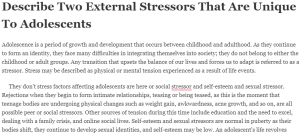Describe Two External Stressors That Are Unique To Adolescents

Adolescence is a period of growth and development that occurs between childhood and adulthood. As they continue to form an identity, they face many difficulties in integrating themselves into society; they do not belong to either the childhood or adult groups. Any transition that upsets the balance of our lives and forces us to adapt is referred to as a stressor. Stress may be described as physical or mental tension experienced as a result of life events.
They don’t stress factors affecting adolescents are here or social stressor and self-esteem and sexual stressor. Rejections when they begin to form intimate relationships, teasing or being teased, as this is the moment that teenage bodies are undergoing physical changes such as weight gain, awkwardness, acne growth, and so on, are all possible peer or social stressors. Other sources of tension during this time include education and the need to excel, dealing with a family crisis, and online social lives. Self-esteem and sexual stressors are normal in puberty as their bodies shift, they continue to develop sexual identities, and self-esteem may be low. An adolescent’s life revolves around fitting in, and identifying sexually outside of what is considered normal (i.e., bisexual, homosexual, transgender/gender neutral) can be stressful. Society does not often tolerate these kinds of sexual identities, and their bullying, teasing, gossip, and family rejection of their decisions contribute to a poor sense of self-esteem. As a result, when puberty is confronted by stressors like these, they feel depressed and resort to action to cope. Social avoidance, behaving violently against others, or self-abuse, as well as consuming alcohol or using drugs, are examples of those behaviors. When these fails to properly relive the stress experienced by the teenager, they may consider or attempt suicide.
Any of the reinforcement or coping mechanisms that may be used are mentioned below. Since nurses’ assessments are critical for understanding stressor signs and symptoms, this would help nurses to understand how the teenager is feeling and speak about it when their adult is not present. As a result, they would feel more at ease debating those topics. We will teach them to talk about their feelings by giving them things to talk about that they are comfortable with. When it comes to suicidal thoughts or acts, ask them simple questions. To ease tension, encourage healthy coping skills such as sports or exercise, listening to music, or praying. If they don’t feel comfortable talking about their emotions, they can write them down in a diary as a stress reliever. Giving them information about support groups where they can go on their own and get assistance is another informative opportunity. Some of the support groups- self-esteem: Teens Health.org, gender identity question or stress associated with the subject: gay, lesbian and straight education Network (www.gisen.org), Bullying: www.bullying.org or kidshealth.org. Depression and suicide are complex issues and get torn on the flesh for adolescents. It is important for nurses to use communication and sensitivity in education for this group.
Respond using 200-300 words APA format with references supporting the discussion.
Describe two external stressors that are unique to adolescents. Discuss what risk-taking behaviors may result from the external stressors and what support or coping mechanism can be introduced.